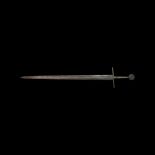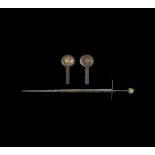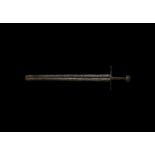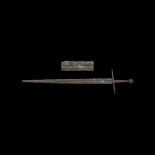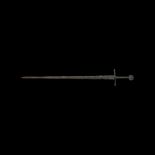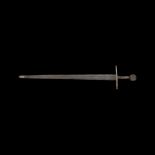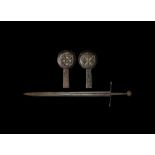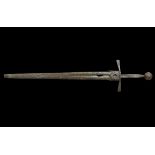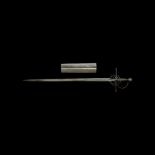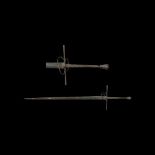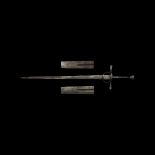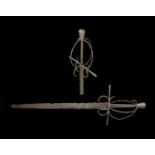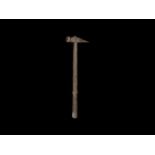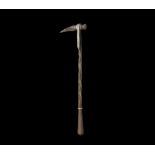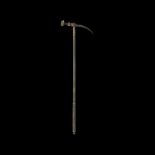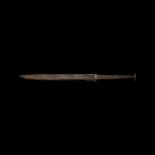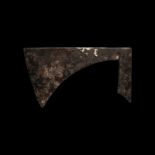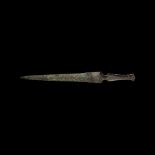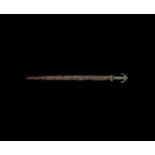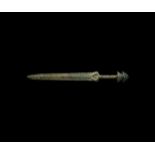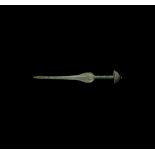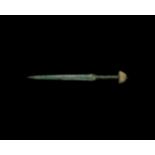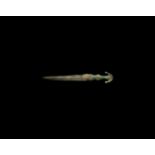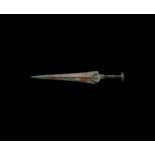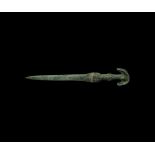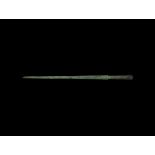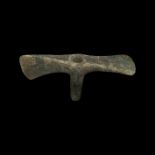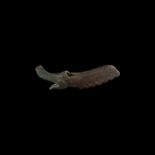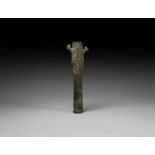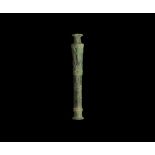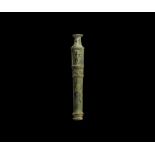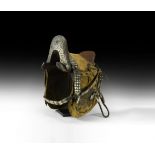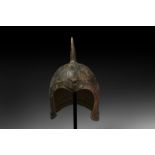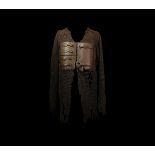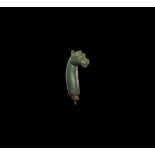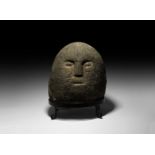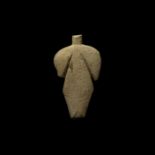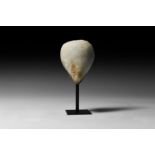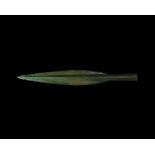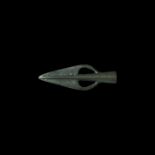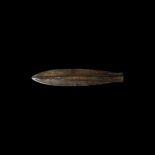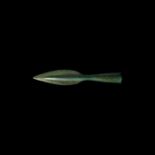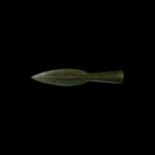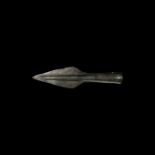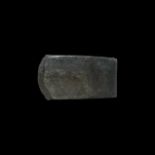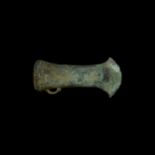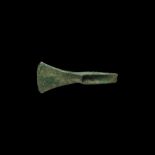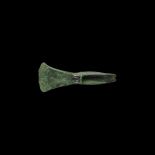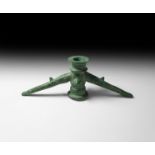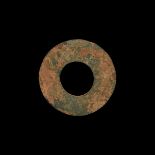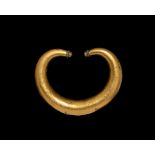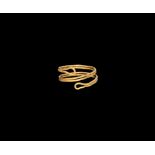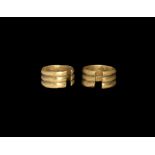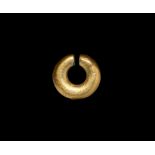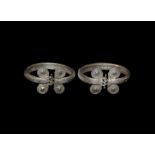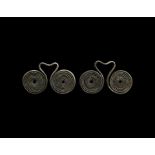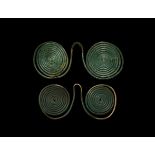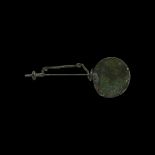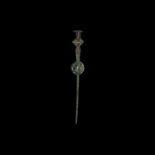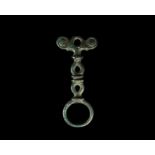Refine your search
Estimate
Category
- Jewellery (165)
- Arms, Armour & Militaria (82)
- Greek, Roman, Egyptian & Other Antiquities (79)
- Sculpture (62)
- Chinese Works of Art (34)
- Taxidermy & Natural History (31)
- Glassware (27)
- Metalware (26)
- Books & Periodicals (22)
- Coins (17)
- Ceramics (15)
- Collectables (15)
- Salvage & Architectural Antiques (13)
- Islamic Works of Art (8)
- Clocks (7)
- Furniture (7)
- Lighting (6)
- Silver & Silver-plated items (6)
- Classic Cars, Motorcycles & Automobilia (5)
- Models, Toys, Dolls & Games (5)
- Sporting Memorabilia & Equipment (4)
- Textiles (4)
- Vintage Fashion (4)
- Russian Works of Art (3)
- Scientific Instruments (3)
- Stamps (3)
- Kitchenalia (2)
- Musical Instruments & Memorabilia (2)
- Watches & Watch accessories (2)
- Decorative Art (1)
- Ethnographica & Tribal Art (1)
- Indian Works of Art (1)
- Japanese Works of Art (1)
- Oil, Acrylic paintings & Mixed Media (1)
- Tools (1)
Filtered by:
- Item Type
- List
- Grid
A subscription to the Price Guide is required to view results for auctions ten days or older. Click here for more information
Medieval Hand-and-a-Half Sword
Early 14th century AD. A Western Middle Age iron half and hand sword from Germany, of Oakeshott's Type XIIIA, cross style 1 (in early form, spike-...
Early-late mid 14th century AD. A Western Middle Age iron longsword from Italy, of Oakeshott's Type XV.A, cross style 8, pommel style J (recessed)...
13th century AD. A double-edged iron sword of Oakeshott's Type XII, with broad, flat, evenly tapering blade, unfortunately broken at three-quarter...
Mid 11th-mid 12th century AD. A Western Middle Age double-edged iron sword, from Central Europe, of Petersen type X-Oakeshott type Xa, with tapere...
Medieval Single-Handed Sword
Early 14th century AD. A Western Middle Age iron longsword, possibly from Italy, of Oakeshott's Type XVI.2, cross style 2, pommel style K, showing...
Medieval Single-Handed Sword
Mid 11th-mid 13th century AD. A Western Middle Age iron sword of Oakeshott type XI or XII, with two-edged blade, gently tapering profile with roun...
Early 14th century AD. An English or German iron longsword of Oakeshott's Type XIIIA, a Bastard sword (sword that can be used also with two hands)...
Later 13th century AD. A double-edged iron longsword of Oakeshott's Type XII (Oakeshott, 1991, p.105), the broad, flat, evenly tapering blade is t...
Early 16th century AD. A Western European rapier of possible Italian manufacture, with 16th-century open basket-hilt sword, still fitted with the ...
Tudor Era Hand-and-a-Half Sword
Mid 16th century AD. A German Renaissance 'hand-and-a-half' or 'Bastard' sword, with double ring guard, double edged broad blade; this gradually t...
Tudor Era Hand-and-a-Half Sword
Mid 16th century AD. A German Renaissance 'hand and a half' or 'Bastard' sword, with ring guard, double-edged broad blade, lenticular in section, ...
Tudor Era Double-Handed Rapier
Mid 16th-early 17th century AD. A rapier of possible Spanish or Italian manufacture; the open basket-hilt sword, fitted with the blade, has straig...
Medieval War Hammer
15th century AD. An iron war hammer with square-section haft, head with flanged striking face, spike to the rear, haft with collar and hole for st...
16th-17th century AD. A war hammer or Nazdiak of Polish origin, the head composed of two pieces; the twisted shaft made of solid iron, and the hea...
Tudor Era Renaissance War Hammer
Late 16th century AD. A Western European war hammer (reiterhammer) made of two pieces, the iron shaft and the head; the head made as a single soli...
Medieval Rondel Dagger
14th-15th century AD. A single-edged dagger with slender piled-iron blade and integral tang, ellipsoid baluster, disc pommel. 174 grams, 42cm (16...
15th-16th century AD. An iron axehead with broad blade, narrow neck and flattened D-section socket, stamped maker's mark to one cheek of reserved ...
1132-1127 BC. A bronze short sword with lentoid-section triangular blade, rectangular guard and hilt socketted to each face to accept an organic i...
8th-7th century BC. A long sword with double-edged iron lentoid-section blade, bronze hilt with scooped lower guard, three beaded collars, crescen...
13th-6th century BC. A narrow triangular blade with shallow midrib, crescentic guard, square-section grip and double conical pommel. 602 grams, 4...
13th-6th century BC. A bronze short sword with leaf-shaped two-edged blade, crescent guard, columnar grip with later moulded pommel. 623 grams, 5...
13th-6th century BC. A bronze short sword with leaf-shaped two-edged blade, crescent guard, columnar grip with later moulded pommel. 510 grams, 5...
Western Asiatic Luristan Dagger
2nd millennium BC. A bronze dagger with lentoid-section leaf-shaped blade, double-waisted grip with transverse ribbed collars, the pommel formed a...
Western Asiatic Luristan Dagger
2nd millennium BC. A bronze dagger or short sword with narrow triangular blade, raised midrib and crescentic guard to each face, round grip with r...
Western Asiatic Luristan Dagger
2nd millennium BC. A bronze dagger with lentoid-section leaf-shaped blade, double-waisted grip with transverse ribbed collars, the pommel formed a...
Mid 1st millennium BC. A bronze javelin-head comprising a round socket with bands of ribbing and bosses, flared mouth, square-section shank, round...
2nd millennium BC. A large bronze axehead with flared adze to one side and similar axe blade to the other, long tubular socket with circumferentia...
Western Asiatic Dragon Axehead
2nd millennium BC. A bronze ceremonial axehead with swept blade, scrolled crest and mouth forming the socket; mounted on a custom-made stand. 366...
13th-6th century BC. A tubular bronze cudgel with raised ribs, two rectangular panels of braid detailing and two flanking couchant lions with head...
13th-6th century BC. A substantial bronze cudgel with balustered finial, raised ropework bands to the cells each with a profile leaping lion. See ...
13th-6th century BC. A tubular bronze macehead with gusseted collar to the lower end, ropework bands with geometric infill below a frieze of profi...
16th-17th century AD. A set of horse tack comprising: saddle with wooden saddle-tree, leather-covered with decorative openwork metal fittings; lea...
Chinese Bronze Helmet
19th century AD. A substantial bronze Zhou style helmet from a statue(?) domed with raised panels to the brim and vertical crest, hollow-formed sp...
Indian Deccan Mailcoat
17th century AD. A thigh-length mailcoat of iron rings (mainly 10-12mm wide) of alternating rivetted and butted construction; full-length sleeves ...
18th-19th century AD. A carved jade grip from a kard dagger with tiger-head(?) finial, pricked ears and slightly open mouth exposing openwork fang...
2nd century BC-2nd century AD. An iconic Pagan sculpture securely dated to the Irish Celtic Period of 200 BC-200 AD, this large and imposing carve...
Anatolian Kila Marble Torso
3rd millennium BC. A carved marble figurine, lentoid in section with columnar neck and incised detailing. 227 grams, 13.5cm (5 1/4"). On the Lond...
Anatolian Kila Marble Idol Head
Mid 3rd millennium BC. A carved marble stylised sub-conical head with step to the reverse; mounted on a custom-made stand. 300 grams total, 14cm ...
8th-4th century BC. A bronze lance head with hollow midrib and lanceolate blade; believed to be one of the largest British examples of the late Br...
2nd millennium BC. A leaf-shaped bronze spearhead with tubular socket extending to the tip of the blade, the blade with bevelled edges and two cre...
Bronze Age Socketted Spearhead
2nd-1st millennium BC. A bronze spearhead with leaf-shaped blade, raised keeled midrib extending to a short flared socket pierced for attachment. ...
Bronze Age Socketted Spearhead
1st millennium BC. A bronze spearhead with leaf-shaped blade and raised midrib extending to a tapering socket. 197 grams, 20.5cm (8"). Private co...
Bronze Age Socketted Spearhead
1st millennium BC. A bronze spearhead with leaf-shaped blade and raised midrib extending a tapering, facetted socket, pierced transversely for att...
Bronze Age Socketted Spearhead
1st millennium BC. A bronze leaf-shaped spearhead with raised midrib extending to a tapering socket, pierced transversely for attachment. 80 gram...
Bronze Age Copper Flat Axe
2nd millennium BC. A substantial bronze flat axe of rectangular form with chamfered edge. 466 grams, 12.6cm (5"). Ex North London gentleman; form...
8th-6th century BC. A bronze looped and socketted axehead with convex edge and lateral spurs, bulbous collar to mouth, raised D-shaped wing to eac...
Middle Bronze Age, 1400-1150 BC. A complete palstave axehead from the Manston hoard pit deposit being one of the best examples in the hoard; trian...
Middle Bronze Age, 1400-1150 BC. A complete palstave axehead from the Manston hoard pit deposit being one of the best examples in the hoard; trian...
13th-9th century BC. A bronze pick comprising a central tube with bulbs and flanged ends, two angled lateral spikes with lugs beneath and two more...
Bronze Age Votive Ingot
2nd millennium BC. A substantial bronze annular votive object with tapering profile. 571 grams, 13cm (5"). Property of a Dutch gentleman; formerl...
2nd-1st century BC. A small bracelet formed as a sheet-gold sleeve over a hollow base-metal or bronze core, crescent-shaped with twisted filigree ...
Bronze Age Gold Coiled Ring
2nd millennium BC. A gold finger ring formed as a coil of parallel wires with loop finials, beaded detailing. 4.11 grams, 22.95mm overall, 20.01m...
Mid 12th-8th century BC. A British triple-banded gold 'ring money' from the late Bronze Age, a composite Collar-Type ring comprising three conjoin...
Bronze Age Gold Ring Money
3rd-2nd millennium BC. A gold clad penannular hair-ring with square-cut ends; possibly used as a form of transportable wealth ('ring money'"). 3....
Iron Age Selonian Bracelet Pair
Later 1st millennium BC. A matched pair of hollow-formed silver bracelets, each with four coiled plaques flanking the hinged closure with cotter-p...
2nd millennium BC. A matched pair of silver pendants, each formed as two coiled ends of a rod with heart-shaped loop between forming a volute scro...
Bronze Age Spiral Pendant Group
2nd millennium BC. A set of two bronze pendants each a pair of wire coils with U-shaped bridge between. 34.2 grams total, 73-91mm (3 - 3 1/2"). F...
8th-5th century BC. A very large bronze brooch comprising a square-section bow with two coils attached to a round-section arm with spiral ribbing ...
Bronze Age Hair Pin with Bulbs
1st millennium BC. A substantial bronze hair pin with disc-shaped head, three ribs and lozenge-shaped bulb below, square section shaft with five r...
Iron Age Celtic Mirror Handle
1st century AD. A bronze handle formed as a broad loop with D-shaped flanged below, two smaller loops with ribs between, volute scroll attachment ...

